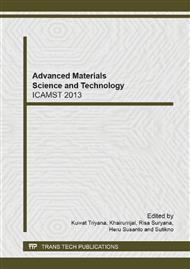[1]
J. Kotas, and Z. Stasicka, Chromium occurrence in the environment and methods of is speciation, Environt. Pollut. 107 (2000) 263-268.
Google Scholar
[2]
F.W. Oehme, In toxicity of heavy metals in the environment, Marcel Dekker Inc., New York, (1979).
Google Scholar
[3]
A.K. Shanker, C. Cervantes, L. Tavira, S. Avudainayagam, Chromium toxicity in plant, Environt. Int. 31 (2005) 739-753.
DOI: 10.1016/j.envint.2005.02.003
Google Scholar
[4]
A. Zhitkovich, Important of chromium DNA adducts in mutagenicity and toxicity in chromium(VI), Chem. Res. Toxicol. 18 (2005) 3-11.
DOI: 10.1021/tx049774+
Google Scholar
[5]
N.I. Sax, In Dangerous Properties Of Industrial material, 6th ed., Van Nostrand Reinhold Co, New York, (1984).
Google Scholar
[6]
Yong, G.Z., H.Y. Shen, S.D. Pan, M.Q. Du and Q.H. Xia, Preparation and characterization of amino functionalized nano-Fe3O4 magnetic polymer adsorbents for removal of chromium (VI) ions, J. Metr. Sci. 45 (2010) 5291-5301.
DOI: 10.1007/s10853-010-4574-5
Google Scholar
[7]
P.L. Hariani, H. Nurlisa, Reduction of Cr(VI) ions in aqueous used FeSO4, J. Science Research 12 (2009) 17-22.
Google Scholar
[8]
S.H. Dewi, and Ridwan, Synthesis and characterization magnetic nanoparticles Fe3O4 for adsorption chromium hexavalen, Indonesian Journal of Material Science, 13 (2012) 136-140.
Google Scholar
[9]
J. Dai, F.L. Ren and C.Y. Tao, Adsorption of Cr(VI) and speciation of Cr(VI) and Cr(III) in aqueous solution using chemically modified chitosan, Int. J. Environ. Res. Public Health, 9 (2012) 1757-1770.
DOI: 10.3390/ijerph9051757
Google Scholar
[10]
Y. Okamoto, Y. Nomura, K. Iwamaru, High preconcentration of ultra trace metal ions by liquid-liquid extraction using water/oil/water emulsion of liquid surfactans membranes, Microchem. Jour., 65 (2000) 341-346.
DOI: 10.1016/s0026-265x(00)00161-2
Google Scholar
[11]
G. Zhang, J. Qu, H. Liu, R. Liu, R. Wu, Preparation and evaluation of a novel Fe-Mn binary oxide adsorbent for effective arsenite removal, Water Res. 41 (2007) 1921-(1928).
DOI: 10.1016/j.watres.2007.02.009
Google Scholar
[12]
X. Liu, M., Fu, S. Y., Zhu, L. P., High-yield synthesis and characterization of monodisperse sub-microsized CoFe2O4 octahedra. J. Solid State Chem. 180 (2007) 461-466.
DOI: 10.1016/j.jssc.2006.11.003
Google Scholar
[13]
M. Namdeo and Bajpai, S.K., Chitosan coated nanocomposite (CMNs) as magnetic carrier particles for removal Fe(III) from aqueous solutions, Colloid Surface 320 (2008) : 161-168.
DOI: 10.1016/j.colsurfa.2008.01.053
Google Scholar
[14]
S. Hashemian, Kinetic and thermodynamic of adsorption of methylene blue by CuFe2O4/rice bran composite, Int. J. Physic. Scien. 6 (2011) 6257-6267.
DOI: 10.5897/ijps11.187.
Google Scholar
[15]
JCPDS card 25-283, International center for diffraction data, Swathmore, PA, (1986).
Google Scholar
[16]
H.M. Lu, W.T. Zheng, and Q. Jiang, Saturation magnetization of ferromagnetic and ferrymagnetic nanocrystal at room temperature, J. Phys. D. Appl. 40 (2007) 320-325.
DOI: 10.1088/0022-3727/40/2/006
Google Scholar


